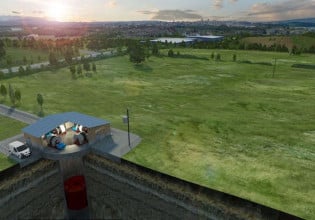Flexible Solar Panels Head Into Space
Lightweight and flexible solar panels have the potential to power a range of small and large future spacecraft.
Space flight presents many challenges. The almost total vacuum outside the Earth’s atmosphere, extremes of heat and cold, and near-constant radiation bombardment are just a few of the problems engineers face when building spacecraft.
There’s another issue people don’t often consider. Since NASA no longer has space shuttles to transport devices into space, they have to fit inside the front half of a metal tube called a rocket.
Space has a lot of, well, space. That means, once they are out there, spacecraft can spread out large solar arrays to produce enough energy to power the machine. However, fitting large rigid solar panels into the tubular confines of a launch vehicle is always a challenge.
Demonstration of NASA’s Lightweight Integrated Solar Array and AnTenna. Image used courtesy of NASA (by NeXolve Holding)
That’s where Ascent Solar comes in. The Colorado-based company has designed and begun manufacturing innovative, featherweight, flexible, and durable copper-indium-gallium-selenide (CIGS) thin-film photovoltaic (PV) solar panels.
Light and Flexible Solar Modules
Ascent Solar’s flexible solar modules will soon fly on a Lightweight Integrated Solar Array and AnTenna (LISA-T) mission. NASA’s Space Technology Mission Directorate will lead the mission, scheduled to launch this summer. The agency’s Marshall Space Flight Center in Huntsville, Alabama, will direct it.
Flexible solar panel. Image used courtesy of Ascent Solar
LISA-T is the fourth in NASA’s Pathfinder Technology Demonstrator (PTD) series of missions evaluating new technologies with potential use in future science and exploration missions. The lightweight and flexible solar array Ascent Solar produces for use in the LISA-T mission is much lighter. It takes up less space during launch than traditional PV solutions while producing as much as three times the power for use by a satellite.
The thin-film PV panels are manufactured by placing thin layers of CIGS material on a 25-micron polyamide substrate, creating featherweight flexible panels.
Ascent’s flexible PV. Image used courtesy of Ascent Solar
The LISA-T mission won’t be the first time Ascent’s PV technology has been in space. Previously, the company’s thin-film CIGS array was tested in harsh space conditions at the International Space Station (ISS) as a part of NASA’s Materials International Space Station Experiment (MISSE-X).
Into the Beyond with Solar
Beyond the LISA-T experiments, the PV array designed by Ascent can be used in standard-size and form-factor CubeSat nanosatellites. At the same time, it can be scaled up to provide kilowatts of generated power for small future spacecraft.
The company is developing its Titan line for space environments with a power output efficiency of 17.55 percent per Titan module. The Titan module is about one square foot in size, 10 grams in weight, with a target power output of 17 watts. Ascent Solar’s goal is to produce kilowatts per kilogram of solar array in the harsh environment of space, with minimal degradation of the solar panels over the life of the mission.









